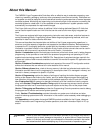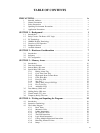
iii
About this Manual:
The OMRON K-type Programmable Controllers offer an effective way to automate processing, man-
ufacturing, assembly, packaging, and many other processes to save time and money. Distributed con-
trol systems can also be designed to allow centralized monitoring and supervision of several separate
controlled systems. Monitoring and supervising can be done through a host computer, connecting the
controlled system to a data bank. It is thus possible to have adjustments in system operation made
automatically to compensate for requirement changes.
The K-type Units can utilize a number of additional Units including dedicated Special I/O Units that
can be used for specific tasks and Link Units that can be used to build more highly integrated sys-
tems.
The K-types are equipped with large programming instruction sets, data areas, and other features to
control processing directly. Programming utilizes ladder-diagram programming methods, which are
described in detail for those unfamiliar with them.
This manual describes the characteristics and abilities of the K-types programming operations, in-
structions, and other aspects of operation and preparation that demand attention. Before attempting
to operate the PC, thoroughly familiarize yourself with the information contained herein. Hardware
information is provided in detail in the
Installation Guide
. A table of other manuals that can be used in
combination with this manual is provided at the end of
Section 1 Introduction
.
Section 1 Introduction
explains the background and some of the basic terms used in ladder-diagram
programming. It also provides an overview of the process of programming and operating a PC and
explains basic terminology used with OMRON PCs. Descriptions of peripheral devices used with the
K-types and a table of other manuals available to use with this manual for special PC applications are
also provided.
Section 2 Hardware Considerations
explains basic aspects of the overall PC configuration and de-
scribes the indicators that are referred to in other sections of this manual.
Section 3 Memory Areas
takes a look at the way memory is divided and allocated and explains the
information provided there to aid in programming. It also explains how I/O is managed in memory and
how bits in memory correspond to specific I/O points.
Section 4 Programming
explains the basics of writing and inputting the ladder-diagram program,
looking at the elements that make up the ‘ladder’ part of a ladder-diagram program and explaining
how execution of this program is controlled and the methods required to input it input the PC. S
ec-
tion 5 Instruction Set
then goes on to describe individually all of the instructions used in program-
ming, while
Section 6 Program Execution Timing
explains the scanning process used to execute
the program and tells how to coordinate inputs and outputs so that they occur at the proper times.
Section 7 Debugging and Execution
provides the Programming Console procedures used to debug
the program and to monitor and control system operation.
Finally,
Section 8 Troubleshooting
provides information on system error indications and other
means of reducing system down time. Information in this section is also necessary when debugging a
program.
The
Appendices
provide tables of standard OMRON products available for the K-types, reference
tables of instructions and Programming Console operations, and other information helpful in PC op-
eration.
WARNING Failure to read and understand the information provided in this manual may result in
personal injury or death, damage to the product, or product failure. Please read each
section in its entirety and be sure you understand the information provided in the section
and related sections before attempting any of the procedures or operations given.
!


















